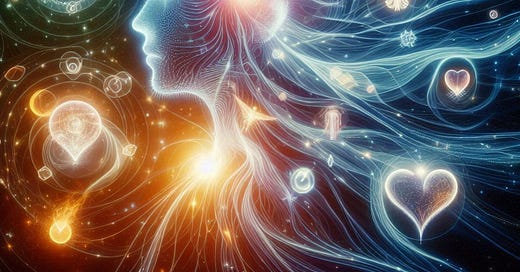The Holy Spirit emerges across religious, spiritual, and mystical traditions not as a concept to be grasped intellectually, but as a living presence to be encountered experientially. This divine reality—known in Hebrew as ruach and Greek as pneuma, meaning breath or wind—represents the animating force that inspires, guides, and transforms human consciousness and community.
In Christian theology, the Holy Spirit stands as the third expression of the Trinity, the breath of God that dwells within and among people. This Spirit awakens love, wisdom, courage, and discernment, empowering prophets, uniting communities, and offering direct access to the Divine that transcends dogma and institution. Yet the Spirit's influence extends far beyond any single belief system, manifesting wherever people align with love, humility, and inner freedom.
The contemplative and interspiritual understanding reveals the Holy Spirit as that interior stirring which moves one toward greater unity, compassion, and truth. It speaks in silence, urges toward justice, and reveals the profound interconnectedness of all life. Some encounter it as deep peace, others as a fire of longing or radical clarity. This Spirit is both gift and calling—often unsettling in its demands, yet deeply healing in its presence.
While the Holy Spirit and love are deeply intertwined, they remain distinct yet inseparable realities. Love—encompassing compassion, kindness, patience, and self-giving—represents the fruit or expression of the Spirit's work. It can be felt, practiced, and expressed by anyone, regardless of belief, emerging as both universal capacity and instinctual response.
The Holy Spirit, by contrast, is the animating presence or energy of the Divine itself. In many traditions, the Spirit is what inspires, awakens, and draws us deeper into love. It is not merely an emotion or ethic, but the living current that reveals love's depth, heals its distortions, and empowers its practice. In this sense, love is what the Spirit produces in us when we are open, attuned, and receptive.
Where love can be misused or misunderstood—confused with attachment, desire, or sentimentality—the Holy Spirit remains the clarifying source that purifies love. The Spirit does not merely feel love; it is the dynamic presence that unveils true love, the kind that is free, inclusive, and aligned with justice and wisdom.
In summary, love is the fruit; the Holy Spirit is the source. Love is what flows outward; the Spirit is what stirs it from within.
A useful analogy emerges from electrical principles: the Holy Spirit is like voltage—the potential, the energy source, the invisible force that empowers, animates, and drives. Love is like amperage—the actual current that flows, the measurable expression of the energy in action.
Voltage without current doesn't accomplish anything—it represents potential without movement. Current without voltage isn't possible—it has no source. Similarly, the Holy Spirit as divine energy or presence makes authentic love possible, and love as action, connection, and compassion becomes the evidence that the Spirit is flowing through someone or something.
This analogy illuminates why love can become distorted when disconnected from its source. When love is rooted in ego or fear, it may still resemble love but lacks the clarity, strength, and wholeness that the Spirit makes possible. In summary, the Spirit is the power; love is the flow. One reveals the other, and they are never separate in a living spiritual life.
This understanding illuminates the Trinity not as abstract metaphysics but as experiential truth—a living relationship that can be understood as love in its fullest expression:
Love Given corresponds to the Source or Creator, traditionally understood as the Father—the origin of love, the initiator, the generous outpouring of being itself.
Love Received relates to the Beloved, traditionally the Son—the full reception and embodiment of that love, reflecting it back with complete trust, fidelity, and surrender.
Love Itself manifests as the Spirit—the shared life, the unifying presence, the mutual exchange and movement between Lover and Beloved that flows outward into the world.
This framing draws on both ancient theological insight and direct contemplative experience. It reveals the Trinity not as a set of fixed roles or doctrines but as a living relationship—love in motion, constantly giving, receiving, and overflowing.
Importantly, this also reflects our human participation in the Divine: we are invited into that same flow—receiving love, offering it, and becoming its expression. The Trinity, then, is less a theory about God and more a mirror of the deepest pattern of reality: relationality, reciprocity, and the movement of love.
Crucially, this divine dance invites human participation. We are called into the same flow—receiving love, offering it, and becoming its expression in the world. The Trinity thus serves less as a theory about God and more as a mirror of ultimate reality, revealing the communion into which we are welcomed, formed, and sent.
The Holy Spirit emerges as the dynamic, indwelling presence of the Sacred that enlivens consciousness, fosters transformation, and unites all things in love. It is the source from which authentic love flows, the voltage that enables love's current to move through human hearts and communities. Understanding the Spirit within the Trinity as Love Itself—the living exchange between Love Given and Love Received—reveals not distant doctrine but intimate invitation into the very life of God.
This Spirit is not bound by belief system or tradition but manifests wherever people open themselves to love, humility, and inner freedom. It speaks in silence and action, in contemplation and justice, in the individual heart and the gathered community. The Holy Spirit remains both the power that makes love possible and the evidence that divine life flows through creation, transforming all who receive it into agents of that same transforming love.




